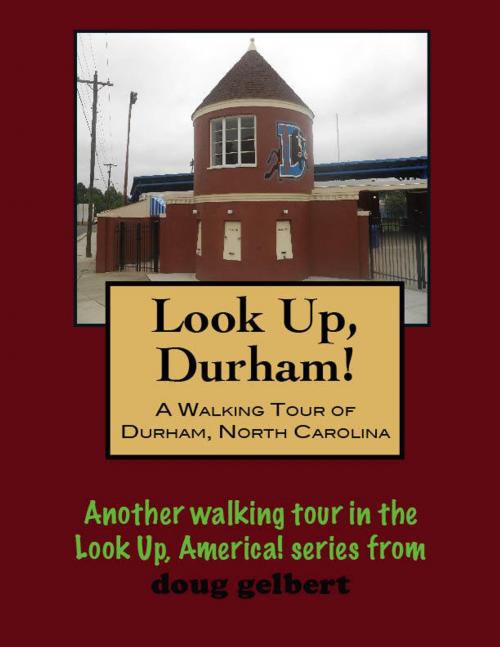| Author: | Doug Gelbert | ISBN: | 9781458111043 |
| Publisher: | Doug Gelbert | Publication: | June 3, 2011 |
| Imprint: | Smashwords Edition | Language: | English |
| Author: | Doug Gelbert |
| ISBN: | 9781458111043 |
| Publisher: | Doug Gelbert |
| Publication: | June 3, 2011 |
| Imprint: | Smashwords Edition |
| Language: | English |
There is no better way to see America than on foot. And there is no better way to appreciate what you are looking at than with a walking tour. Whether you are preparing for a road trip or just out to look at your own town in a new way, a downloadable walking tour is ready to explore when you are.
Each walking tour describes historical and architectural landmarks and provides pictures to help out when those pesky street addresses are missing. Every tour also includes a quick primer on identifying architectural styles seen on American streets.
In the early 1850s the steam locomotives of the newly formed North Carolina Railroad could not make the haul between Raleigh and Hillsborough without stopping for more wood and water. Another depot was needed. Established plantation owners in the target area between the two towns were hard sells, however, to get land for a new depot. Finally Dr. Bartlett Durham donated four acres of land for that new station and got the village that sprung up around the tracks named for him.
Not that it was much of an honor at the time - there were fewer than 100 residents in Durham's Station in 1865 when the two largest intact armies remaining from the Civil War stared down each other from Raleigh (William T. Sherman's Union troops) and Greensboro (Joseph E. Johnston's Confederate forces). No fighting would take place, however, as the largest troop surrender of the war was negotiated three miles west of Durham's Station at James and Nancy Bennett's farm.
While there wasn't any official fighting there was more than a little looting by the soldiers and one of their favorite booties was a mild flavor of tobacco discovered around Durham. After the veterans returned home many wrote letters to Durham trying to get more of that tobacco. John Ruffin Green was one of the first to fill those orders.
The Duke family home outside Durham was one of those farms stripped bare by marauding Union soldiers as they marched through North Carolina. Family legend has it that a small quantity of bright leaf tobacco was overlooked, providing a tiny lifeline. The family, including 9-year old James Buchanan, gathered the tobacco and sorted it into small packages labeled "Pro Boro Publico." They hitched their blind mules to a wagon and drove to the southern part of North Carolina where tobacco was scarce. Their small supply sold easily and the money was reinvested into more tobacco. By 1872 the Dukes had sold 125,000 pounds, one of the leading producers in the area. The tobacco was processed in a log house factory in what is now the heart of Duke University.
In 1878, at the age of 22, James Duke took charge of W. Duke & Sons and in 1883 he traveled to New York to introduce his firm to the national tobacco business. Tobacco wars broke out and older companies offered to buy Duke's company. He had other ideas and consolidated all his competitors under the banner of American Tobacco, with Duke as its president. He was 34 years old.
The Department of Justice broke up the Duke tobacco trust in 1910 and Duke turned to generation of electricity and providing cheap power to the South. Although he himself had little use for education, In 1924 Duke endowed tiny Trinity College with as much as $135,000,000, mostly from his holdings in Southern Power. The school was named after him and became one of the world's great private universities and forever linking the Duke name with Durham, even after the tobacco factories have long since been converted into condominiums.
Our tour to see how this tobacco town was built will start at the city center at the life-sized, one-ton bronze statue of the city's emblem, the Durham Bull...
There is no better way to see America than on foot. And there is no better way to appreciate what you are looking at than with a walking tour. Whether you are preparing for a road trip or just out to look at your own town in a new way, a downloadable walking tour is ready to explore when you are.
Each walking tour describes historical and architectural landmarks and provides pictures to help out when those pesky street addresses are missing. Every tour also includes a quick primer on identifying architectural styles seen on American streets.
In the early 1850s the steam locomotives of the newly formed North Carolina Railroad could not make the haul between Raleigh and Hillsborough without stopping for more wood and water. Another depot was needed. Established plantation owners in the target area between the two towns were hard sells, however, to get land for a new depot. Finally Dr. Bartlett Durham donated four acres of land for that new station and got the village that sprung up around the tracks named for him.
Not that it was much of an honor at the time - there were fewer than 100 residents in Durham's Station in 1865 when the two largest intact armies remaining from the Civil War stared down each other from Raleigh (William T. Sherman's Union troops) and Greensboro (Joseph E. Johnston's Confederate forces). No fighting would take place, however, as the largest troop surrender of the war was negotiated three miles west of Durham's Station at James and Nancy Bennett's farm.
While there wasn't any official fighting there was more than a little looting by the soldiers and one of their favorite booties was a mild flavor of tobacco discovered around Durham. After the veterans returned home many wrote letters to Durham trying to get more of that tobacco. John Ruffin Green was one of the first to fill those orders.
The Duke family home outside Durham was one of those farms stripped bare by marauding Union soldiers as they marched through North Carolina. Family legend has it that a small quantity of bright leaf tobacco was overlooked, providing a tiny lifeline. The family, including 9-year old James Buchanan, gathered the tobacco and sorted it into small packages labeled "Pro Boro Publico." They hitched their blind mules to a wagon and drove to the southern part of North Carolina where tobacco was scarce. Their small supply sold easily and the money was reinvested into more tobacco. By 1872 the Dukes had sold 125,000 pounds, one of the leading producers in the area. The tobacco was processed in a log house factory in what is now the heart of Duke University.
In 1878, at the age of 22, James Duke took charge of W. Duke & Sons and in 1883 he traveled to New York to introduce his firm to the national tobacco business. Tobacco wars broke out and older companies offered to buy Duke's company. He had other ideas and consolidated all his competitors under the banner of American Tobacco, with Duke as its president. He was 34 years old.
The Department of Justice broke up the Duke tobacco trust in 1910 and Duke turned to generation of electricity and providing cheap power to the South. Although he himself had little use for education, In 1924 Duke endowed tiny Trinity College with as much as $135,000,000, mostly from his holdings in Southern Power. The school was named after him and became one of the world's great private universities and forever linking the Duke name with Durham, even after the tobacco factories have long since been converted into condominiums.
Our tour to see how this tobacco town was built will start at the city center at the life-sized, one-ton bronze statue of the city's emblem, the Durham Bull...















